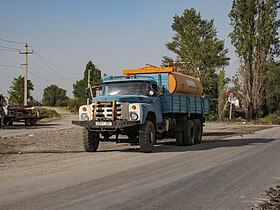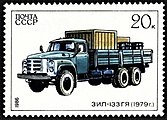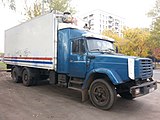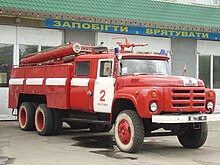
Pegaso was a Spanish manufacturer of trucks, buses, tractors, armored vehicles, and, for a while, to train apprentices, and have a good brand image, some sports cars. The parent company, Enasa, was created in 1946 and based in the old Hispano-Suiza factory, under the direction of the renowned automotive engineer Wifredo Ricart. In 1990, Iveco took over Enasa, and the Pegaso name became a secondary brand of Iveco.

A dump truck, known also as a dumping truck, dump trailer, dumper trailer, dump lorry or dumper lorry or a dumper for short, is used for transporting materials for construction as well as coal. A typical dump truck is equipped with an open-box bed, which is hinged at the rear and equipped with hydraulic rams to lift the front, allowing the material in the bed to be deposited ("dumped") on the ground behind the truck at the site of delivery. In the UK, Australia, South Africa and India the term applies to off-road construction plants only and the road vehicle is known as a tip lorry, tipper lorry, tipper truck, tip truck, tip trailer or tipper trailer or simply a tipper.

A dumper or dumper truck or dump truck is a truck designed for carrying bulk material, often on building sites. A dumper has a body which tilts or opens at the back for unloading and is usually an open 4-wheeled vehicle with the load skip in front of the driver. The skip can tip to dump the load; this is where the name "dumper" comes from. They are normally diesel powered. A towing eye is fitted for secondary use as a site tractor. Dumpers with rubber tracks are used in special circumstances and provide a more even distribution of weight compared to tires. Continuous tracks allow the operator to carry heavier payload on slick, snowy, or muddy surfaces, and are popular in some countries. Rubber track dumpers offer even weight distribution for transporting heavy payloads over challenging terrains like mud or snow, popular in certain regions. Roll Off Dumpsters, contrastingly, are large, stationary containers designed for substantial waste management, easily loaded and transported by specialized trucks.

Six-wheel drive is an all-wheel drive drivetrain configuration of three axles with at least two wheels on each axle capable of being driven simultaneously by the vehicle's engine. Unlike four-wheel drive drivetrains, the configuration is largely confined to heavy-duty off-road and military vehicles, such as all-terrain vehicles, armored vehicles, and prime movers.
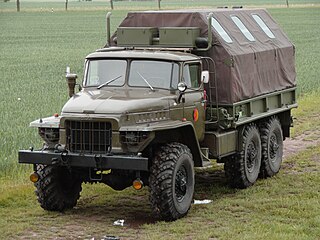
The Ural-375 is a general purpose 4.5 ton 6×6 truck produced at the Ural Automotive Plant in the Russian SFSR from 1961 to 1993. The Ural-375 replaced the ZIL-157 as the standard Soviet Army truck in 1979, and was replaced by the Ural-4320.
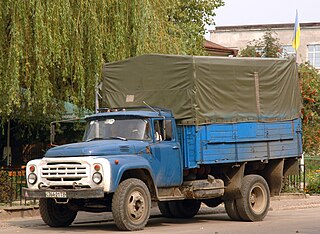
The ZIL-130 is a Soviet/Russian truck produced by ZIL in Moscow, Russia. The first prototype was built in 1956. Production began in 1962, while mass production started in 1964. It was one of the most numerous cargo trucks in the USSR and Russia, in total ZIL built 3,380,000 trucks up to 1994. In 1995, production was moved to the now-defunct Ural Motor Plant.

The Urals Automotive Plant, an Open Stock Company, is a major Russian manufacturer of off-road trucks under the Ural brand. Located in the city of Miass, Chelyabinsk Oblast in the Ural Mountains. The plant was established in 1941; when the ZiS truck plant was evacuated from Moscow during World War II.

Bryansk Automobile Plant is a Russian manufacturer of military vehicles based in Bryansk, Russia.

OJSC «Autodiesel» known as the Yaroslavl Motor Plant (YaMZ), Russian: Яросла́вский мото́рный заво́д (ЯМЗ), romanized: Yaroslavskyi Motornyi Zavod (YaMZ), based in Yaroslavl, Russia, is an open joint-stock company that produces engines for many Russian companies.

MAZ-200 was a Soviet truck manufactured at the Minsk Automobile Plant. It was the first Soviet truck powered by a diesel engine. The MAZ-200 was initially produced by YaAZ between 1947 and 1950, after which the production was moved to MAZ.

MAZ-500 is a Soviet truck manufactured at the Minsk Automobile Plant. The first prototype MAZ-500 ran as early as 1955 and they were shown to the public in 1958. Delays in engine development pushed full production back to 1965, although limited production started in 1963. The MAZ-500 is a cab over truck instead of the MAZ-200's conventional layout. This was done to increase payload and reduce weight as well as reduce fuel consumption. The engine itself was quite modern, a direct injection 11,150 cc (680 cu in) diesel V6 built by the Yaroslavl Motor Plant with 180 PS (132 kW) at 2100 rpm. The truck's design was also innovative, with a tilting cabin, which was still rare in the West as well. It also had a number of features designed to make the truck operable under the arduous conditions found in Siberia.

GAZ-3307 and GAZ-3309 are fourth-generation Russian trucks produced by the medium-duty Gorky Automobile Plant. The flatbed truck carburetor GAZ-3307 was announced in late 1989, and the turbodiesel truck GAZ-3309 was announced at the end of 1994.

The KrAZ-255 is a Ukrainian three-axle off-road truck with six-wheel drive, intended for extreme operations. It was manufactured at the KrAZ plant beginning from 1967.

The KrAZ H27.3EX or KrAZ 7634HE off-road truck 8x8 is manufactured at the KrAZ plant in Ukraine. It was first presented in the 2014 year.

The BAZ-6909 is a Russian artillery tractor and missile vehicle that was developed as a successor to the MAZ-537 and MAZ-7310 by Bryansk Automobile Plant. It can haul semi-trailers and loads with mass of 13-21 metric tons, both on and off-road.

The KamAZ-4326 is a four-wheel drive truck produced by Kamaz in Naberezhnye Chelny. The vehicle has been in production since 1995 and is also designed for military applications. With the KamAZ-4350, there is a modernized successor. The KamAZ-43114 is very similar to the KamAZ-4326, but has three axes instead of two.

The KamAZ-4310 is an all-wheel drive truck produced by Kamaz in Naberezhnye Chelny. The vehicle was built in series in different versions from 1981 to 1995, a very similar successor is still on the market today with the KamAZ-43114, also in different versions.
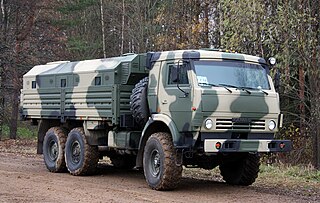
The KamAZ-5350, also known as "Mustang" is a six-wheel drive truck produced by Kamaz in Naberezhnye Chelny. The vehicle has been in production since 2003 and is also designed for military applications. With the KamAZ-53501, there is a version with a slightly lower payload.
